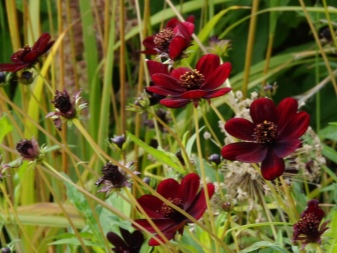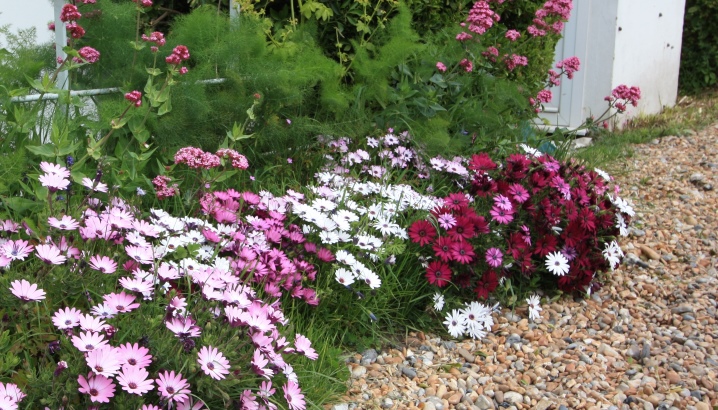Kosmeya chocolate: description, planting and care

Kosmeya chocolate is an amazing plant native to sunny Mexico. Why is it so attractive to gardeners?


Description
Cosmos atrosanguineus (chocolate kosmeya, black kosmeya, chocolate cosmos) is a perennial that grows up to 1.5 meters in height. The flowers of the cosmos are medium-sized - only 4.5 cm in diameter, the petals are velvety, with a slightly openwork edge, there may be 6, 8 or 10 of them.
The color of the chocolate cosme, contrary to its name, is not brown at all, but deep burgundy. The name was given to her by the aroma - vanilla-chocolate, very pronounced. Because of him, the plant almost disappeared from the face of the Earth - people tore cosmea for bouquets, not caring about its cultivation. Here you need to make a note that in the wild, the seed material of black cosmos gives a very small percentage of germination. Therefore, the plant survived only thanks to the selection work of specialists who restored its population at home.


Chocolate kosmeya is quite light-requiring, cold-resistant, undemanding to the soil, but it takes root best of all in places enriched with nutrients and with a loose soil structure.
The harsh winters of some regions of our country dictate their own conditions, and the kosmeya, although it is winter-hardy, often freezes. However, this does not mean at all that it cannot be cultivated, for example, in Siberia. You just need to choose one of the following planting methods: either in a container, which you have to bring into the heat for the winter, or grow it in the open field as an annual plant, without worrying about how it will overwinter.


Planting and leaving
Kosmeya chocolate is a godsend for an amateur gardener. It can grow in dry and cool areas, in a shaded area and in the sun. However, it is worth remembering that greenery will grow in the shade, and flowers will grow in the light. It is necessary to pay attention to the frequency of planting: plant a cosmea densely - it will delight you with flowering, rarely with foliage.
The ideal soil for planting chocolate cosme is loosened, drained, flavored with mineral and organic fertilizers. But here you should be careful not to oversaturate the soil. Otherwise, a lush green cap will appear, but the flowers will not be enough.

Let's talk about the reproduction of this wonderful flower. The best way to do this is by sowing seeds.
- In the spring, starting in March, seed is sown in open ground or in a cool greenhouse. This should be done like this: place the seeds on the surface of the earth, deepen them a little, but do not cover them, as they will need light to germinate.
- The air temperature should be kept within plus 15-19 degrees - then the seeds will hatch in a couple of weeks.
- When the shoots reach a height of 10 cm, thin out the planting.
- In May, you can plant young plants in open ground with an interval of 30-35 cm between them.
There is an opinion that the seed material takes root well and springs up during autumn planting - well, if the winters in your climate are mild enough and the soil does not freeze, try this option.




You can store seeds for 3 years, after this period they lose their germination.
Now let's talk about the nuances of caring for chocolate cosme. They are as follows.
- After planting the plant in open ground, it should be well watered. Further, the procedure for irrigating the soil should be repeated no more than once a week, pouring 3-4 liters of warm settled water under each plant. Water the cosme in the evening, do not let the drops fall on the leaves and buds.
- Periodically weed the plantings and loosen the ground around - this will be the key to obtaining lush and healthy cosmos bushes.
- As for fertilizers: if the soil on your site is already not poor, you will not need to additionally feed the chocolate cosmea. If there is a lack of nutrients in the soil, add double superphosphate during budding of the plant and pour it with mullein solution.
- If your plantings have grown up to one and a half meters, it is recommended to tie them up to avoid damage by gusty winds or heavy rainfall.
- When the bud is blooming, it must be cut to stimulate the appearance of young flowers and give the cosme a neat appearance. In the autumn season, it is also recommended to shorten the stems, leaving about 15 cm above ground level.
- To obtain seed, leave the largest faded buds, and let the seeds ripen there.



Pests and diseases
The indisputable advantage of chocolate cosme is that it is practically not susceptible to any diseases. Harmful insects also bypass the plant. The only exceptions are slugs and snails that parasitize young seedlings. They must either be collected mechanically (by hand), or sprinkle the soil under the plantings with any preparation to combat them.
Chocolate kosmeya, being such a “tough nut”, also protects neighboring plants from pest attacks. The fact is that its flowers are very attractive to the lacewing, an insect whose larvae eat the eggs of aphids, moths, ticks and worms.
So if you plant your chocolate beauty next to your garden crops, you will not only be able to enjoy its beauty and aroma, but also protect the rest of the plantings from the encroachments of villains.


Application in landscape design
Kosmeya chocolate is a very attractive plant, often used to decorate the landscape of a personal plot. And here's how you can do it:
- plant in containers, flowerpots, wooden boxes and use them to decorate the veranda, window sill;


- create an abundant planting along the hedge, hiding possible design flaws;

- you can also plant a plant near the house, especially if the walls at the bottom are not very attractive and require masking;

- you can often see kosmeya growing near bushes or trees: with its bright buds, it will create a contrast with the greenery of larger plants, revive the garden;

- it is recommended to choose tagetes, phlox, chamomile, ageratum, echinacea, calendula, verbena, nasturtium, amaranth, cloves as "partners" for chocolate cosme - they can be planted in a row, forming a live border, or in a group, for example, on a stone slide or garden bed;

- very often you can see kosmeya in flower beds near various institutions - as a rule, it grows on a lawn in the style of nature garden.

An unpretentious fragrant bright perennial plant that can please any gardener is the chocolate cosmeya. You will never regret it if you decide to decorate your personal plot with it.
About the chocolate cosme, see below.







































































































The comment was sent successfully.